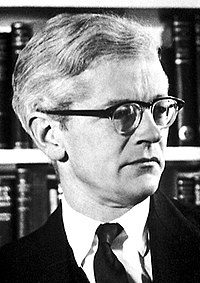John Kendrew
| John Kendrew | |
|---|---|

John Kendrew
|
|
| Born | John Cowdery Kendrew 24 March 1917 Oxford, England |
| Died | 23 August 1997 (aged 80) Cambridge, England |
| Nationality | United Kingdom |
| Fields | Crystallography |
| Institutions |
Peterhouse, Cambridge Royal Air Force |
| Alma mater | University of Cambridge |
| Doctoral advisor | Max Perutz |
| Known for | Heme-containing proteins |
| Notable awards |
|
Sir John Cowdery Kendrew, CBE, FRS (24 March 1917 – 23 August 1997) was an English biochemist and crystallographer who shared the 1962 Nobel Prize in Chemistry with Max Perutz; their group in the Cavendish Laboratory investigated the structure of heme-containing proteins.
He was born in Oxford, son of Wilford George Kendrew, reader in climatology in the University of Oxford, and Evelyn May Graham Sandburg, art historian. After prep school at the Dragon School in Oxford, he was educated at Clifton College in Bristol, 1930–1936. He attended Trinity College, Cambridge in 1936, as a Major Scholar, graduating in chemistry in 1939. He spent the early months of World War II doing research on reaction kinetics, and then became a member of the Air Ministry Research Establishment, working on radar. In 1940 he became engaged in operational research at the Royal Air Force headquarters, holding the honorary rank of Wing Commander R.A.F.
During the war years, he became increasingly interested in biochemical problems, and decided to work on the structure of proteins.
In 1945 he approached Max Perutz in the Cavendish Laboratory in Cambridge. Joseph Barcroft, a respiratory physiologist, suggested he might make a comparative protein crystallographic study of adult and fetal sheep hemoglobin, and he started that work.
...
Wikipedia
